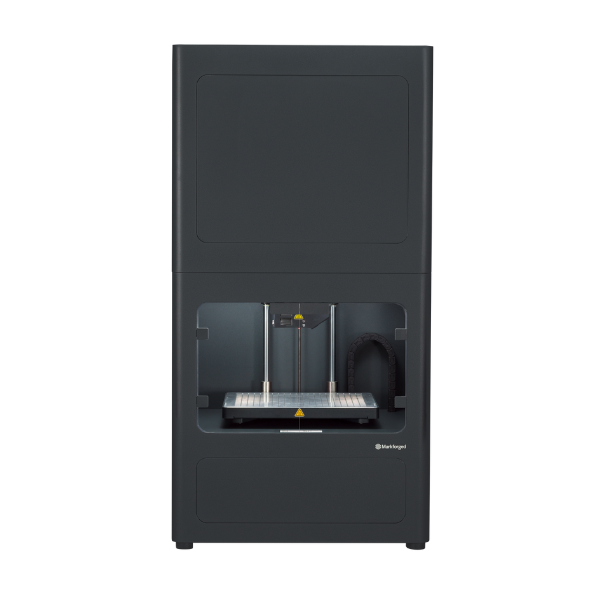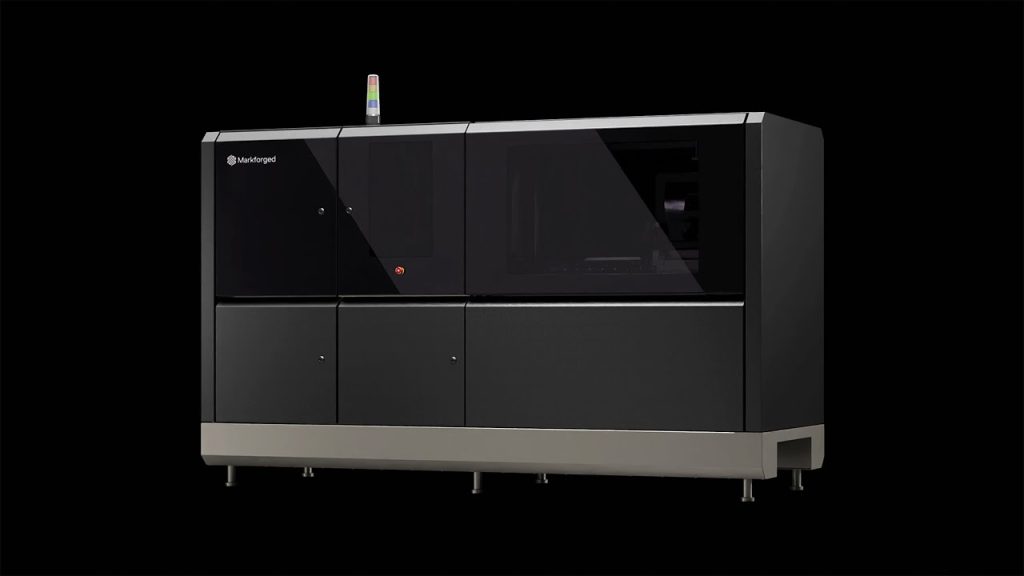Building metal components and models with a 3D printer is possible with two different technologies from Markforged. The first route into metal 3D printing is a variation of metal FFF called Bound Powder Extrusion (BPE) with the Metal X, which deposits plastic-bound metal filament in layers through a heated nozzle.
BPE filament is extruded very similar to standard FFF 3D printing, yielding a “green” part that contains metal powder in waxy polymer.
Parts printed with the Metal X require additional debinding and sintering stages to remove the plastic and turn parts into solid metal.
The second technology is Binder Jetting with the Markforged PX100, which bonds loose metal powder with a liquid binding agent layer by layer to build models without heat during printing (sintering stages are still necessary).
Binder Jetting is significantly faster than metal FFF / BPE for batch production of precise parts because fresh powder can be deposited faster than extrusion-based technologies can match, thanks to multiple heads that jet powder in several places simultaneously. Also, parts don’t require supports during printing.
The Metal X
The Metal X System is fantastic for businesses and manufacturers looking for an accessible entry into metal 3D printing.

Angus 3D Solutions, a Scottish 3D printing service company, demonstrated the power of rapid metal additive manufacturing in a time-sensitive project for the oil and gas industry.
When approached with an urgent request for custom tight-clearance wrenches needed on an offshore rig within 6 days, Angus 3D Solutions leveraged their Markforged Metal X System to deliver a solution.
Traditional manufacturing methods would have taken 2-3 weeks, far exceeding the deadline. Even laser powder bed fusion technology would have required 10 days. However, Angus 3D Solutions produced the custom wrenches using the Metal X System in just 3 days.
This quick turnaround allowed their customer to meet the 6-day deadline for delivery to the offshore rig. Rapid manufacturing saved $25,000 in freight costs and potentially prevented millions in unplanned downtime for the end client.
Overall, the Metal X’s print speeds are excellent, although you need to factor in additional debinding and sintering stages to get a true workflow depiction.
It offers layer resolutions between 85μm to 170μm post-sintering, providing an excellent detail range for many applications, and produces most parts within 24 hours.
Related: What is metal 3D printing, and how does it work?
Turbo Mode offers enhanced print speeds for 17-4PH v2 Stainless Steel parts – on average, it enables printing 35% faster, though some parts can exceed this speed increase. It uses larger layer heights to boost print speeds. Specifically, Turbo Mode prints at a 0.2 mm layer height, which results in a 0.17 mm layer height post-sintering.
Smaller-scale production, prototyping, and businesses that want to reduce reliance on external suppliers for metal parts are perfect users.
It prints:
- 17-4PH Stainless Steel
- Copper
- H13 Tool Steel
- Inconel 625
- A2 Tool Steel
- D2 Tool Steel
Additionally, the Metal X system uses:
- Release Material: Ceramic that becomes powder during the sintering process
- Media: Bound powder metal filament (supplied in spools)
The PX100
The PX100 is for higher volume production and more advanced manufacturing needs. It could be a core part of your production process, either something new or supplementing traditional manufacturing methods.

Manufacturers looking to insource critical production runs, reduce waste, and create complex parts that may be difficult or impossible to produce with traditional methods are candidates for a PX100 on the factory floor.
It can print speeds up to 1,000 cm3 per hour—incredibly fast, thanks to a printhead with 70,400 nozzles delivering 2pL droplets at 15.5 kHz.
Key design features include an easily exchangeable powder magazine for fast material and build changeover, 1600 dpi resolution with industry-leading accuracy and repeatability, and close to 100% excess powder recycling.
It prints:
- 17-4PH Stainless Steel
- 316L Stainless Steel
- Alloy 247
- Alloy 625
- 4140 Steel
- Alloy 718
- H13 Tool Steel
- Copper
- D2 Tool Steel
- Ti6Al4V (Titanium alloy)
Markforged Digital Forge
It isn’t just a metal 3D printer and Eiger software you get with the Metal X and PX100. The Digital Forge, Markforged’s innovative additive manufacturing platform, makes these machines infinitely more capable than others.
Powered by AI fleet learning from 10,000+ connected printers and over 10 million completed prints, the Digital Forge continuously improves through over-the-air updates.
It’s the world’s most secure additive manufacturing platform with ISO/IEC:27001 and ISO:9001 certification.
The cloud-enabled enterprise software provides comprehensive management tools, including fleet management, BI dashboards, and user provisioning, with open APIs for system integration. This makes the Digital Forge a robust, secure, and intelligent solution for modern manufacturing needs.
Summing up
Markforged’s metal 3D printers allow for the production of functional metal parts in-house without the need for extensive training or dedicated operators.
Speed is built into the Metal X and PX100 – the Metal X for smaller production runs and the PX100 for large-scale metal manufacturing of complex geometric structures, internal details, and even integrated parts.
Phasing out intensive CNC machining and hand tooling can result in significant cost savings over time, potentially millions, depending on scale.
Contact us for more information about any system.




